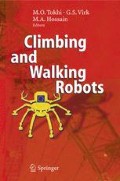Abstract
In this work, we present a practical approach for producing a stable 3D gallop in a simulated quadrupedal robot which includes the prominent characteristics of the biological gait. The dynamic model utilizes biologically-based assumptions, and the resulting 3D gallop contains the prominent biological features of early leg retraction, phase-locked leg motion, a significant gathered flight phase, unconstrained spatial dynamics, and a smooth gait. A multiobjective genetic algorithm is used to find control parameters in a partitioned search space. During stance, a simple energy control law ensures a fixed amount of energy in the knee springs during each stride, which is a key factor for stabilization.
Access this chapter
Tax calculation will be finalised at checkout
Purchases are for personal use only
Preview
Unable to display preview. Download preview PDF.
References
Raibert M. H. (1990) Trotting, Pacing, and Bounding By a Quadruped Robot. Journal of Biomechanics, vol. 23, pp. 79–98.
Furushu J., Akihito S., Masamichi S. and Eichi K. (1995) Realization of a Bounce Gait in a Quadruped Robot with Articular-Joint-Type Legs. Proceedings of the 1995 IEEE International Conference on Robotics and Automation (ICRA), Nagoya, Japan, pp. 697–702.
Kimura H., Akiyama S. and Sakurama K. (1999) Realization of Dynamic Walking and Running of the Quadruped Using Neural Oscillator. Autonomous Robots, vol. 7, pp. 247–258.
Hoyt D. F. and Taylor C. R. (1981) Gait and the Energetics of Locomotion in Horses. Nature, vol. 292, pp. 239–240.
Gambaryan P. P. (1974) How Mammals Run: Anatomical Adaptations. John Wiley & Sons, New York, NY, pp. 23–37.
Smith J. A. and Poulakakis I. (2004) Rotary Gallop in the Untethered Quadrupedal Robot Scout II. Proceedings of the International Conference on Intelligent Robots and Systems (IROS), Sendai, Japan, pp. 2556–2561.
Morita K. and Ishihara H. (2005) A Study of Mechanisms and Control of Underactuated 4-Legged Locomotion Robot: Proposal of Walking Model by Underactuated System. Video Proceedings of the 2005 IEEE International Conference on Robotics and Automation (ICRA), Barcelona, Spain.
Nanua P. and Waldron K. J. (1994) Instability and chaos in quadruped gallop. Journal of Mechanical Design, vol. 116, pp. 1096–1101.
Ringrose R. (1997) Self-Stabilizing Running. Proceedings of the 1997 IEEE International Conference on Robotics and Automation (ICRA), Albuquerque, NM, pp. 487–493.
Marhefka D. W., Orin D. E., Schmiedeler J. P. and Waldron K. J. (2003) Intelligent Control of Quadruped Gallops. IEEE/ASME Transactions on Mechatronics, vol. 8, no. 4, pp. 446–456.
Herr H. M. and McMahon T. A. (2001) A Galloping Horse Model. The International Journal of Robotics Research, vol. 20, no. 1, pp. 26–37.
Krasny D. P. and Orin D. E. (2004) Generating High-Speed Dynamic Running Gaits in a Quadruped Robot Using an Evolutionary Search. IEEE Transactions on Systems, Man, and Cybernetics, Part B: Cybernetics, vol. 34, no. 4, pp. 1685–1696.
McMillan S., Orin D. E. and McGhee R. B. (1995) DynaMechs: An Object Oriented Software Package for Efficient Dynamic Simulation of Underwater Robotic Vehicles. Underwater Robotic Vehicles: Design and Control, (Yuh J., ed.), Albuquerque NM, TSI Press, pp. 73–98.
Craig J. J. (1989) Introduction to Robotics: Mechanics and Control, Addison-Wesley Publishing Co., Reading MA, pp. 48–49.
Heglund N. C. and Taylor C. R. (1988) Speed, Stride Frequency and Energy Cost per Stride: How Do They Change with Body Size and Gait? Journal of Experimental Biology, vol. 138, pp. 301–318.
Marhefka D. W. (2000) Fuzzy Control and Dynamic Simulation of a Quadruped Galloping Machine. Ph.D. thesis, The Ohio State University, Columbus, Ohio.
Berkemeier M. (1998) Modeling the Dynamics of Quadrupedal Running. International Journal of Robotics Research, vol. 17, no. 9, pp. 971–985.
Author information
Authors and Affiliations
Editor information
Editors and Affiliations
Rights and permissions
Copyright information
© 2006 Springer-Verlag Berlin Heidelberg
About this paper
Cite this paper
Krasny, D.P., Orin, D.E. (2006). A 3D Galloping Quadruped Robot. In: Tokhi, M.O., Virk, G.S., Hossain, M.A. (eds) Climbing and Walking Robots. Springer, Berlin, Heidelberg. https://doi.org/10.1007/3-540-26415-9_56
Download citation
DOI: https://doi.org/10.1007/3-540-26415-9_56
Publisher Name: Springer, Berlin, Heidelberg
Print ISBN: 978-3-540-26413-2
Online ISBN: 978-3-540-26415-6
eBook Packages: EngineeringEngineering (R0)

